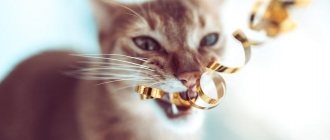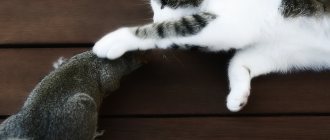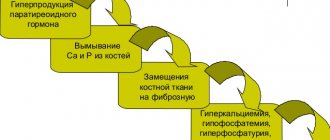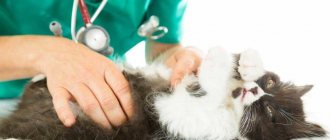Causes of stomatitis
Depending on the causes, all stomatitis is divided into primary and secondary. The first category develops on its own and has its own specific causes of occurrence. The second category of stomatitis occurs as a concomitant symptom of some other underlying disease of a viral, fungal or bacterial nature.
Causes of primary stomatitis
- any mechanical injuries (scratches, punctures, wounds) due to something foreign getting into the mouth or due to an incorrect bite;
- chemical and thermal effects (the influence of ice water or excessively hot food, irritating chemicals entering the mouth, chewing poisonous-irritating plants, etc.);
Causes of secondary inflammation
- fungal, viral or bacterial infections (for example, panleukopenia - feline distemper, candidiasis, leukemia, etc.);
- food allergic reactions;
- pathologies of the liver, kidneys and gastrointestinal tract (gastroenteritis, uremic syndrome, hepatitis, etc.);
- endocrine pathologies in metabolism (diabetes mellitus);
- diseases of the masticatory apparatus (tartar, caries, autoimmune reactions).
Causes of stomatitis in cats and kittens
There can be quite a few causes of stomatitis. Depending on the root cause of the development of the inflammatory process, the disease is divided into two types:
- Primary
– occurs as a result of the impact of negative factors on the mucous membrane. - Secondary
– manifests itself as an addition to an animal’s existing disease.
Among the main reasons for the development of primary stomatitis in cats are:
- poor hygiene , which in turn leads to the proliferation of pathological microorganisms that provoke an inflammatory process;
- microtraumas that an animal can receive during play or when chewing bones with sharp edges;
- feeding errors - food too hot or too cold;
- chemical burns , which can be caused by contact with the mucous membrane with household chemicals or aggressive medications for external use.
Important! The oral mucosa is very delicate and any aggressive influence can provoke an inflammatory process, which without proper treatment quickly turns into stomatitis, because cats’ saliva contains a large number of different microorganisms.
Also at risk are animals that already have problems in the oral cavity:
- carious teeth;
- plaque;
- tartar;
- periodontitis.
Thus, by eliminating provoking factors by performing regular hygiene procedures and, if necessary, hardware techniques available in veterinary offices, the likelihood of primary stomatitis can be minimized.
The disease of the secondary type must be treated in conjunction with the main disease. In most cases, when it is possible to cure the primary disease or achieve a state of remission, stomatitis also recedes.
Secondary stomatitis in cats can occur with such ailments as:
- parasitic infections;
- diseases caused by viruses, fungi or bacteria;
- diabetes;
- hormonal imbalance;
- disturbances in the functioning of the immune system.
Types of inflammation of the oral cavity, how they manifest themselves
According to their course, inflammation of the oral cavity can be acute or chronic. Acute stomatitis has a clear clinical manifestation and develops quickly. Chronic stomatitis has a sluggish clinical course and can provoke general malaise in the cat.
According to their distribution in the mouth, they are divided into focal and diffuse - focal do not cover the entire mouth, diffuse most often affect the entire mucous membrane of the oral cavity, including the gums, the inner surface of the cheeks, lips and palate. According to the course and manifestation of stomatitis in cats, the symptoms are very diverse:
CatarrhCatarrhal stomatitis occurs most often - the beginning of all complicated stomatitis in the case of improper or neglected treatment. Classic signs of inflammation are intense redness, swelling, sore gums, increased salivation, and unpleasant odor from the mouth. Plaque may appear on the gums and inner surface of the cheeks. Often develops against the background of diseased teeth or tartar. The saliva is viscous and smells unpleasant. |
Papillomatous stomatitisThis is the result of the life activity of the papilloma virus in the cat’s body, i.e. full-fledged viral stomatitis. In the area of the cheeks and lips, cauliflower-shaped growths form on the mucous membrane. With normal functioning of the immune system, after 7-12 weeks everything goes away on its own as suddenly as it appeared. If this does not happen, surgical removal of papillomas will be accompanied by appropriate antiviral and immunostimulating therapy. |
Diphtheritic formIt is very rare in cats and is manifested by the formation of a white coating, which is difficult to remove, and underneath there are areas of even greater inflammation or even bleeding ulcers. |
Phlegmonous stomatitisIt is characterized by an accumulation of pus under the first thin layer of mucous membrane, which changes color from bright pink to gray and bluish. When the places of such accumulations are punctured, pus is released. The risks of sepsis (blood poisoning) are very high; oral cleaning is often carried out under general anesthesia. |
Gangrenous stomatitisIn most cases, it is a complication of ulcerative or phlegmonous. The mucous membrane simply begins to die. A sharp, foul odor emanates from the mouth. Surgical stripping of the affected tissue is clearly indicated. There are high risks of developing sepsis and death of the pet. Often accompanied by fever and enlarged submandibular lymph nodes. |
Ulcerative formUlcerative - weeping ulcers are found over the entire surface or in places, the size and depth of which depends on the cause of occurrence and the duration of the disease. Body temperature may rise. If during the treatment the healing of ulcers does not occur correctly, then this form develops into ulcerative stomatitis with granulations (overgrowth with pathological connective tissue) and, further, into necrosis (complete death of the mucous membrane with complete disruption of its functions). |
A special form of stomatitis, in which inflammation develops against the background of the body’s rejection of its own teeth. Very clear signs of inflammation are observed right around the dental arcades, and near all of them. The course is greatly complicated when infectious agents are attached. Conventional treatment according to the classical scheme does not produce absolutely any results. Tooth extraction cannot be avoided. |
Uremic syndromeThe most severe complication of chronic renal failure. Usually precedes the death of the animal. This form of stomatitis can only be determined using laboratory blood tests. It occurs due to toxic substances that accumulate in the blood of a sick animal, causing irritation and inflammation from the inside. |
Symptoms of stomatitis
5 main signs of stomatitis that should alert the owner and prompt them to examine the cat’s mouth:
- excessive production of saliva, literally dripping from the mouth when the cat is at rest;
- the cat often washes itself, carefully rubbing the mouth area, as if something is bothering it there;
- frequent drinking (drinks almost constantly);
- weak appetite or refusal even of your favorite treats;
- disheveled, unpleasant-smelling fur (the cat, in the process of licking, stains the fur with “bad” saliva).
In addition to the above symptoms, there may also be:
- jumps in body temperature;
- lethargy, inactivity, drowsiness;
- enlarged lymph nodes under the lower jaw;
- unpleasant odor from the mouth;
- complete loss of interest in food;
- pinkish saliva (with impurities of ichor or blood);
- visible swelling and swelling of the lips;
- ulcers, pus, neoplasms, tooth loss.
List of symptoms
Popular The cat's paw pads are peeling: what could it be?
It is known that stomatitis can be chronic or occur in an acute form. In any case, characteristic signs will appear.
One of the first signs that your pet is sick may be his refusal to eat or difficulty eating food when the cat chews slowly and carefully. It is easy to distinguish an animal that is not hungry from a sick one. If a cat is hungry, it will go to the food and put a piece in its mouth, but then hesitate and spit out, as if the food is too hot. This suggests that it hurts her to eat. This behavior is a reason for examination, at least independently at home.
When you examine your cat's mouth, you may notice redness and swelling of the gums.
Other symptoms of developing gangrenous stomatitis are:
- red, swollen gums;
- gray plaque in the oral cavity;
- drooling or bleeding;
- enlarged lymph nodes;
- swelling of the lips;
- increased body temperature;
- strong cadaverous odor from the mouth, similar to the smell of rotting flesh;
- dehydration and weight loss;
- lethargy, unmotivated aggression, secrecy can be signals that the animal is in pain;
- when you try to open your pet’s mouth, he will try to interfere with all his might - bite, pull out, hit with his paw.
An additional sign of an incipient illness may be that the cat stops licking its fur and washing itself as usual. The fact is that every movement of the jaws and tongue causes pain.
Cats do not know how to signal pain with sounds, but they always try to get rid of it by shaking their faces against the corners of various objects. This is a clear sign of pain in the mouth.
Over time, inflammation can spread from the gums to distant areas such as the palate and pharynx, and the gums can become so inflamed that they block the functionality of the oropharynx, making it painful and difficult for the animal to swallow.
Without timely treatment, the cat may die as a result of blood poisoning. Therefore, if your pet exhibits one or more of the above symptoms, you need to contact a veterinarian, he will make a diagnosis and prescribe treatment.
Popular Why might a cat sneeze?
How to examine a cat's oral cavity?
The entire procedure should be carried out slowly, talking affectionately to the pet. The examination usually begins with the gums and teeth, for which the lips are simply raised and lowered.
To look exactly into the mouth, you need to take the cat by the head with one hand along with the upper jaw, so that the thumb and middle finger are at the corners where the jaws meet. Lightly press down on the toothless edge along with the cheek so that it seems to slightly fall into the mouth on the sides. The cat will reflexively open its mouth. Then, with the thumb of your second hand, lightly press the incisors of the lower jaw, holding the chin. The mouth will be open and you can examine it carefully.
Help at home before visiting the veterinarian
A visit to the veterinarian is required! Only a specialist will be able to determine what the exact cause of the inflammation was. Without its definition, treatment of stomatitis in cats at home will be pointless, the whole process will become chronic, and this already threatens a deterioration in the general state of health. Moreover, sometimes there may be such pain during examination that treatment manipulations are possible only after introducing it under general anesthesia, and this can only be done in a veterinary clinic.
You can try to help yourself at home only with the initial forms of stomatitis. Self-treatment of extensive ulcerative stomatitis is a reckless decision that can lead to the death of the cat.
What can you do before visiting a veterinarian?
- Remove traumatic objects from the mouth, if any - thorns, bones, blades of grass, etc. If you cannot remove anything from the soft tissues, it makes sense to immediately go to the veterinarian.
- Rinse the mouth using a small rubber bulb, a disposable syringe without a needle with a rubber piston (dispenses liquid smoothly) or a spray bottle (you can take a washed bottle from any old medicine that gave a fine spray): 3% hydrogen peroxide (it is important not to overdo it, so as not to provoke vomiting if accidentally swallowed);
- strong herbal infusions, such as: oak bark, sage, chamomile, string (200-250 ml of boiling water is poured into a container where 1 tsp of one name or mixture of herbs is poured; everything is infused closed for up to half an hour; diluted with boiled water up to 500 ml and brought to room temperature);
- a slightly pink solution of manganese (1:10000) or furatsilin 1:5000 (0.1 g per 0.5 l of boiled water);
- warm 1% soda solution (1 tsp/l of warm boiled water);
- alcohol tincture of calendula, diluted with boiled water in a ratio of 1:10 (1 part tincture, 10 parts water);
- an aqueous solution of methylene blue for treating single ulcers (sold at any pharmacy).
When rinsing, the stream of liquid should be directed to the surface of the gums, slightly tilting the cat's head forward. All liquid products will spread throughout the oral cavity; there is no need to pour anything directly into the mouth (with the exception of the tongue)! It is advisable to do such rinsing after each meal or at least twice a day.
There is no need to do anything additional if tartar, extensive ulcerative or gangrenous stomatitis are detected. Only a specialist can remove tartar, and in case of deep stomatitis, local exposure alone is not enough; antibiotic therapy or even surgical intervention will be required. In such cases, the owner can only help by delivering the pet to the veterinary hospital as soon as possible.
You should definitely put your cat on a special diet of soft, liquid, slimy and jelly foods. Strictly monitor the temperature of the food - it should not be too cold or too hot. For drinking, it is best to use water at room temperature. At first, only acidophilus is recommended from dairy products. If the ulcers are extensive and deep, after washing the mouth and until the visit to the veterinarian, you can go on a fasting diet with free access to water (up to 24 hours).
Treatment
Important! Do not self-medicate. Advanced stages can be life-threatening for the animal. Often, the use of folk remedies is ineffective for serious lesions of the mucous membrane.
Depending on the type of infection detected, the doctor will prescribe a course of drug treatment, which may include:
- antibiotics, antiviral or antifungal agents;
- analgesics to reduce pain;
- cleaning and antiseptic treatment of mucous membranes;
- drugs to enhance immunity.
For complex advanced forms of stomatitis, the veterinarian may recommend inpatient treatment with round-the-clock monitoring, administration of medications and supportive drugs through a drip. Also, in some cases, the animal may require surgical intervention (removal of teeth or part of the mucous membrane). But such cases do not occur often in practice. Treatment of uncomplicated catarrhal and ulcerative stomatitis in cats most often takes place at home with a visit to the veterinarian according to a set schedule. In this case, the owner’s main task is to strictly follow the recommendations. You can alleviate your pet’s condition and promote a faster recovery by following simple recommendations:
- only liquid food for the period of treatment;
- complete refusal of milk (the milk environment is beneficial for the development of bacteria);
- feeding in small portions through a syringe (without a needle), if there is a complete refusal to eat;
- treatment of the mucous membrane with a 1% soda solution, Lugol or herbal decoctions (calendula, string, oak, sage, chamomile) as recommended by a doctor
. - constant monitoring of the animal's condition.
Remember that when treating stomatitis, folk remedies are used only in complex treatment and under the supervision of a veterinarian. Chamomile will not eliminate inflammation caused by a bacterial or viral infection. Moreover, an incorrectly selected rinsing solution can aggravate the animal’s condition.
Important! Stomatitis can be contagious. its infectious forms can easily be transmitted from animal to animal, as well as from animal to person, so it is very important to isolate other pets living in the house from the big cat during the treatment period and strictly observe the rules of personal hygiene.
Video on how to properly treat a cat’s mouth with Lugol:
Veterinary assistance from a specialist
The diagnosis is made not only on the basis of clinical signs and asking the owner about the pet’s condition and lifestyle over the past few days. Laboratory tests of blood, sometimes urine, and necessarily tests for viral infections are also taken into account. The disease is complex, the clinic is diverse, the correct diagnosis is very important!
In case of a purulent process, before starting treatment with antibiotics, it is advisable to culture the discharge from the mouth in order to accurately determine the susceptibility of the pathogen to a particular antibacterial agent. For gangrenous stomatitis, several different types of antibiotics are often used.
Help is provided through medication, surgery or a combination. What type of therapy is needed is decided individually.
- Surgical assistance consists of prompt removal of the affected mucosa, which has undergone such changes that it is no longer possible to restore it. Moreover, such severely affected areas will interfere with the healing process of relatively healthy tissue. This also includes tooth extraction for autoimmune stomatitis - one of the prerequisites for successful treatment. Important: when removing teeth, do not remove more than two units at a time and be sure to put sutures on the gum flaps to bring the edges of the socket together - this way healing will occur many times faster.
- Combination therapy consists of surgical cleaning of the oral cavity, tooth extraction and further drug treatment.
- The standard course of medical care includes the following points: cleansing the oral cavity of pus and traces of tissue decay;
- suppression of infections during secondary inflammation (antibiotics for stomatitis are prescribed in most cases);
- healing of ulcerated mucosa (after signs of inflammation have disappeared);
- increasing the overall immunity of the animal.
Antiseptics and disinfectant solutions for the oral cavity
- Lugol's solution with glycerin or Lugol's spray for stomatitis (glycerin is included) show excellent disinfecting properties: to treat ulcers directly - smear or spray. You can replace it with an iodine glycerin mixture (1 part iodine + 4 parts glycerin). Important: long-term use is avoided, because can provoke the proliferation of Pseudomonas aeruginosa, which is not affected by iodine;
- Chrorgexidine 0.05% - for washing the mouth or treating wounds and ulcers directly;
- Rotocan is rarely used for mouth treatment in cats, because... in most cases it provokes already excessive salivation;
- Dentavedin gel is used up to 2-3 times a day, applied in a thin layer to sore gums, or placed directly into the sockets after tooth extraction;
- Metrogil-denta in the form of a gel is applied in a very thin layer to areas of inflammation or ulceration. It is important not to overdose, so as not to provoke increased side effects - vomiting, thirst, indigestion, loss of appetite;
- 1-5% solution of Protargol - irrigate the oral cavity in case of inflammation or cauterize ulcers, wounds or sites to remove papillomas with the same type of stomatitis.
Features of the treatment of feline stomatitis
Stomatitis in a cat should be treated by a veterinarian after examination and diagnosis. If you do not yet have the opportunity to visit a specialist, provide the animal with rest, warm and fresh water.
Don't worry about temporary lack of appetite. If a cat refuses to eat for several days, there is no threat to its health.
The main thing is to provide proper antiseptic oral care and eliminate the influence of provoking factors.
These simple folk methods can cure stomatitis in cats in the initial stages:
- rinsing the mouth with a rubber bulb and any antiseptic (hydrogen peroxide, miramistin, chlorhexidine);
- rinsing the mucous membrane with a slightly pink solution of potassium permanganate;
- irrigation of inflamed tissues with a weak soda solution;
- treatment of single ulcers with methylene blue solution.
It is prohibited to use highly concentrated products, alcohol and other aggressive substances that can further irritate the tissues of the oral cavity. When treating, direct the liquid onto the gums, while tilting your pet's head slightly forward. Be sure to use available antiseptics after each meal. This will significantly reduce the risk of secondary infection and complications in the cat.
It is necessary to show the animal to a veterinarian, even if the pet feels satisfactory after home treatment. The specialist may prescribe additional agents, including Lugol's solution, rotokan, dental anti-inflammatory and analgesic gels. Surgical assistance is often required, especially with concomitant diseases of the gums and teeth.
How does a veterinarian treat stomatitis?
Antibiotics, antimicrobials, antivirals and antifungals
- Lincomycin 10% - a course of 3 to 7 days at a dose of 2 ml/10 kg for intramuscular administration and 1 ml/10 kg for intravenous administration;
- Amoxicillin 15% - single injection in a dose of 1 ml/10 kg (or 15 mg/kg) under the skin or into the muscle; if necessary, you can re-inject after 48 hours;
- Oxytetracycline – 0.1 ml/kg body weight once a day for a course of up to 5 days (minimum 3);
- Nystatin and Oxolinic ointments, Levorin, Cholisal and Kamistad gels are applied topically to areas of inflammation and ulceration in a very thin layer, avoiding overdose; have: antifungal, antiviral, anti-inflammatory, wound healing and analgesic effects.
Wound healing
- Actovegin-gel - apply a thin layer to wounds and ulcers in the mouth 2-3 times a day after signs of inflammation have disappeared;
- rosehip oil - smear directly onto the ulcers for faster healing;
- Levomekol (Methyluracil) - apply a thin layer to ulcers and wounds up to 3 times a day, you don’t have to worry about getting into the gastrointestinal tract.
Immunostimulating agents
- Gamavit - 0.3-0.5 ml/kg once a day up to 3 times every 7 days for 2-4 weeks.
- Catozal – 0.5-2.5 ml/animal, depending on the size and severity of the condition, once, repeated after 3-5 days (as necessary);
- Hemobalance – 2-3 times/week. at a dose of 0.25 ml/animal if the weight is up to 5 kg and 0.5 ml/animal if the weight exceeds 5 kg.
Adjuvant therapy for autoimmune stomatitis
- Cyclosporine - 7 mg/kg once daily for 4-16 weeks, depending on the severity of the cat's condition. If disorders in the gastrointestinal tract appear, then the initial dose is ½ of the main daily dose, increasing to the daily dose in 2-3 days;
- Prednisolone is used to suppress inflammation or for targeted immunosuppression. In the first case, the dose will be 0.5 mg/kg twice a day at the beginning of therapy, and after a few days the maintenance dose will be up to 1 mg/kg every other day. In the second case, the main dosage is 1-3 mg/kg twice a day, maintenance - up to 2 mg/kg also every other day.
Diagnostic measures and therapeutic methods
To make an accurate diagnosis, interviewing the animal owner and analyzing obvious symptoms of the disease is not enough. The veterinarian prescribes:
- Blood test, less often urine test.
- Testing for viral pathogens.
- Cultures of secretions from the oral cavity (in case of purulent inflammation before antibiotic therapy) to identify the resistance of the pathogen to certain antibacterial drugs.
A sick animal may require medication, surgery, or a combination of treatments.
Surgery. During surgery, affected areas of mucous tissue that have undergone irreversible changes are excised. Otherwise, the infection will spread further, preventing healthy tissue from healing. If we are talking about stomatitis of an autoimmune nature, then in this case the teeth are removed. This is a necessary measure, without which it is impossible to cure a sick animal.
During one operation, only 1-2 teeth are removed, with the obligatory application of sutures to the tissue of the gingival flaps.
If the edges of the holes are not brought together, the healing process will proceed extremely slowly. In the process of combined treatment, the mouth is surgically cleaned, teeth are removed and appropriate medications are prescribed.
Drug treatment. Drug therapy for stomatitis consists of:
- Cleansing. The oral cavity is cleaned of purulent discharge and necrotic tissue with special solutions and preparations.
- Antibacterial agents. The activity of pathogens during secondary infection is suppressed by antibiotics. Gangrenous stomatitis often requires the use of several antibiotics.
- Immunostimulants, vitamin and mineral supplements, since it is important to support and strengthen the immune system of a sick pet.
Disinfecting solutions. Mouth products with antiseptic and disinfectant effect:
- Lugol (you can use a glycerin composition, an aqueous solution or a preparation in the form of a spray) - perfectly disinfects the mucous membrane of stomatitis. The product can be used to treat ulcers. But this drug is not suitable for long-term use, since it can provoke the activity of the bacterium Pseudomonas aeruginosa, against which iodine is useless.
- Liquid antiseptics - Miramistin, Octenisept, Betadine, Bactoderm. They can be used to rinse the animal’s mouth or apply topically to wounded, ulcerated areas.
- Dentavedin - a gel product is recommended to be used no more than 2-3 times a day. It should be applied to areas affected by pathogens. The drug is also suitable for placing in the cavity left after tooth extraction.
- Metrogyl-Denta - gel should be used to treat inflammatory lesions and ulcers. Overdose should be avoided, as this may increase the side effects of the drug.
- Silver proteinate – 1-5% colloidal solution should be irrigated into the pet’s mouth; you can cauterize ulcerations or damage left after excision of papillomas.
Antiviral and antifungal therapy
The veterinarian usually prescribes a combination of medications. In addition to antibacterial agents, medications with antiviral and antifungal effects are used:
- Lincomycin 10% is a lincosamide antibiotic with a pronounced bactericidal effect. Available in the form of a solution for intramuscular injection, single dose – 1 ml.
- Amoxicillin 15% - administered once, dose - 15 mg per kilogram of weight. In some cases, a second injection is required after 2 days. Veterinary analogues: Amoxilong, Amoximag, Vetrimoxin, Clamoxil.
- Oxytetracycline hydrochloride (and other tetracycline drugs).
- Gels for topical application - you can use Nystatin, Oxolinic ointment, Cholisal and their analogues. A small amount of them should be applied to inflammations and ulcers. Before use, you should read the instructions, as the drugs have a number of contraindications and side effects. They fight fungal pathogens, viruses, eliminate inflammation, relieve pain and restore damaged tissue.
- Wound healing agents: Actovegin-gel, Levomekol, rosehip oil. They are recommended to be used after eliminating the inflammatory process.
- Immunostimulants - Gamavit, Glycopin, Katozal, Imunofan, Mexidol-vet are actively used in veterinary medicine. The duration of the course is 3-8 days.
Other medications. For a disease of autoimmune origin, additional treatment is required, so the following is prescribed:
- Cyclosporine - 7 mg for every 1 kg of weight for 0.5-2 weeks, depending on the severity of the disease. If the disease is accompanied by a gastric upset, then a half dose is initially prescribed, which is increased to normal within 2-3 days.
- Prednisolone - the action of this synthetic glucocorticoid is aimed at suppressing inflammation or immunosuppression.
Also watch the video of stomatitis in cats:











